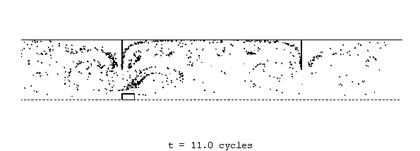Two-dimensional numerical simulation of OFM
If the flow is assumed to be two-dimensional (axisymmetric) and space periodic (i.e., the flow field in each inter-baffle region is identical), the continuity and Navier-Stokes equations can be solved numerically using a vorticity-stream function formulation. A numerical solution was obtained using a finite difference solver where the vorticity transport equation is used to step forward in time (using the explicit leapfrog method of DuFort and Frankel) and the Poisson relationship between the vorticity and stream function is used to calculate the stream function (using a block iterative method coupled with a multi-grid accelerating scheme).
A good match was verified between the numerical solution and Laser Doppler Velocimetry data for both the axial and radial components (Hayden et al., 1996). Azimuthal velocity data supported the axial symmetry assumption for the flow at low Reynolds numbers. However, the breakdown of this symmetry for a value of the oscillatory flow Reynolds number around 200, limits the validity range of the numerical results.
Mixing rates in this system have been quantified using two different approaches (e.g. Neves-Saraiva and Mackley, 1997) - one based on the kinematic mixing rates (i.e. the mixing rates due to the fluid mechanics only) and the other based on the concentration distribution of a passive diffusive tracer. The former looked at the evolution of time-averaged stretch rates of infinitesimal fluid line elements and their spatial distribution. For the more pragmatic concentration based approach, tracer concentrations were calculated by tracking a large number of diffusive particles using a Langevin type equation (i.e., introducing a random walk term). From the time evolution of the concentration variance, the system's mixing rate can be calculated.
 |
| Figure 1. Instantaneous tracer patterns from OFM fluid simulations. |
We observed that a good correlation between the two methods existed and that the concentration based mixing rates were independent of the value of molecular diffusion (for the range corresponding to liquids).
References
ESS Hayden, MR Mackley, RMC Neves-Saraiva, and M Funes Gallanzi (1996), 'Real time measurements of velocity fluctuations in periodic and chaotic flows using LDV and PIV.' Proceedings of the 5th World Congress of Chemical Engineering, San Diego, California, July 14-18. Session 5 - Fluid mechanics and transport phenomena, 1, 456-461.
RMC Neves-Saraiva and MR Mackley (1997), 'Quantitative description of the mixing rates in oscillatory flow through baffled tubes.' Proceedings of the 1997 IChemE Jubilee Research Event, 8-9 April 1997, Nottingham, 1, 229-232.
Return to OFM Numerical Simulations Introduction

